- Details
- Written by: admin
- Category: terms
- Hits: 2775
The Direction attribute is intended to identify two principal horizontal directions of the building plan. It is possible to specify different Lateral Load-Resisting System (LLRS) and the corresponding Material of the Lateral Load-Resisting System in two directions called Direction X and Direction Y; these systems are often referred to as Hybrid Systems or Mixed Systems. Where it is possible to specify directions, Direction X is parallel to street, and Direction Y is perpendicular (orthogonal) to street. In some cases, it is not possible to identify Direction X and Direction Y - thus the user can select Unspecified Direction.
Note that other types of hybrid systems can be described by the Hybrid Lateral Load-Resisting System attribute, which should be applied in one of the following cases: a) there is more than one LLRS in the building, but there is no clear distinction between LLRSs in directions X and Y, or b) there is only one LLRS, but two or more materials of the LLRS are used in different portions of the building.
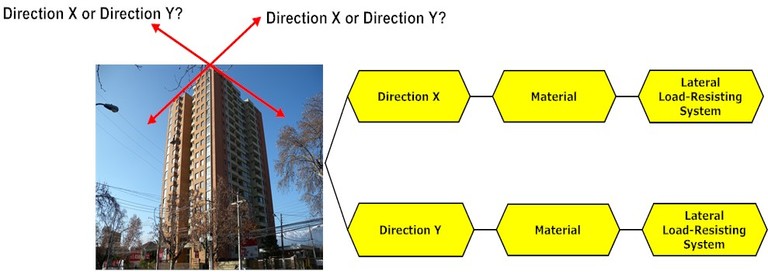
A building showing possible orientation for Directions X and Y
EXAMPLE 1: A building has two different LLRSs: reinforced concrete flat plate (slab and column system) parallel to street, and reinforced concrete wall system perpendicular to street, as shown below. In this case, Direction X (parallel to street) is associated with a flat plate system (LFLS) (see Section 2), and Direction Y (perpendicular to street) is associated with a wall system (LWAL) (see Section 1).

EXAMPLE 2: The Direction attribute can be used to describe a hybrid LLRS from Chile, with reinforced concrete frames in longitudinal direction (Direction X) and confined masonry in transverse direction (Direction Y). It is assumed that Direction X (parellel to street) is longitudinal direction because entrance to individual housing units is in that direction (M. O. Moroni Yadlin).

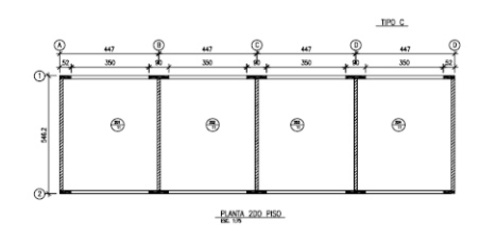
EXAMPLE 3: The Direction attribute can be used to describe a hybrid system from Chile, where confined masonry is used in one direction and reinforced concrete shear walls in other direction (Moroni, Gomez, and Astroza, Chile, World Housing Encyclopedia Report 8). The photo shows an earthquake-damaged building, and the drawing shows a typical building plan (not related to the building shown on the photo).
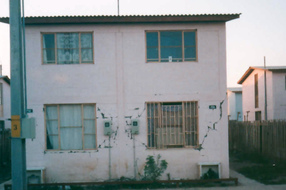
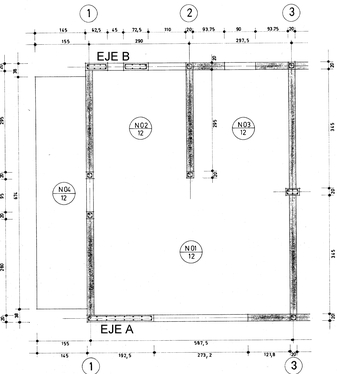
- Details
- Written by: admin
- Category: terms
- Hits: 815
Granite is a light-colored igneous rock with a random arrangement of minerals grains large enough to be visible with the unaided eye. Granite is a coarse-grained, light-colored igneous rock composed mainly of feldspars and quartz with minor amounts of mica and amphibole minerals. This mineral composition usually gives granite a red, pink, gray or white color with light and dark mineral grains scattered throughout the rock. Granite polishes well and resists weathering and acid rain. Granite is hard and difficult to shape into regular blocks; for that reason it is mostly used for random rubble or semi-dressed stone masonry construction. Granite is generally resistant to scratching by metal.

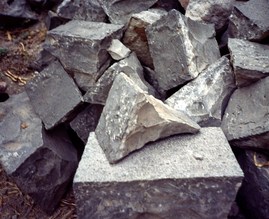
Granite is used for wall construction in Maharashtra, India (S. Brzev)
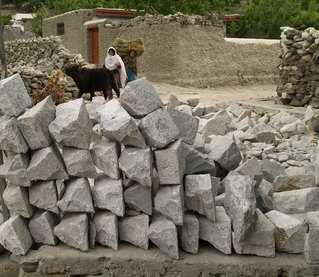
Granite stone boulders prepared for construction, Pakistan (T.Schacher)
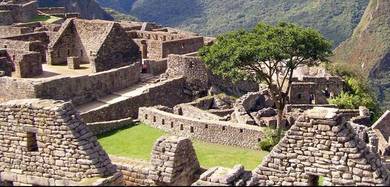

Granite was used for the construction of Inca building complex, Macchu Picchu, Peru (S. Brzev)
- Details
- Written by: admin
- Category: terms
- Hits: 738
The construction was completed before the World War II, thus the year entered is 1939.
- Details
- Written by: admin
- Category: terms
- Hits: 6476
Steel members and steel reinforcing are not designed nor constructed to undergo plastic deformation before failure under earthquake loads. In the event of over-load during an earthquake structural members are expected to suffer brittle failure. For example, moment frames with weak columns and strong beams are non-ductile because once the columns are damaged they usually are unable to resist gravity loads. Reinforced concrete frames will also be classified as non-ductile if beam and column ties have 90 degree rather than 135 degree hooks, and if there is insufficient quantity and spacing of shear reinforcement to prevent shear failure before flexural failure.
Unreinforced masonry buildings usually demonstrate non-ductile performance in earthquakes.
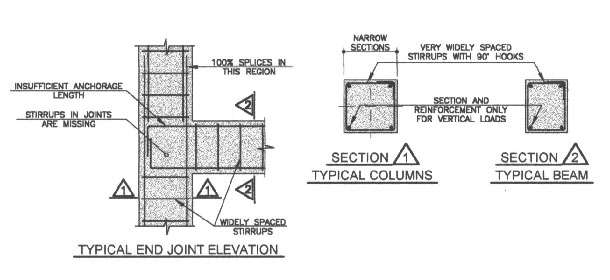
Details of a non-ductile reinforced concrete frame at critical locations: beam-column joint, beam and column (L.G. Mejia, Colombia, World Housing Encyclopedia Report 11)
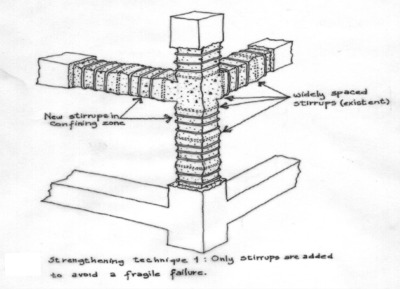
Widely spaced transverse reinforcement (ties in columns and stirrups in beams) are characteristic for non-ductile reinforced concrete frame; this isometric drawing shows a possible seismic strengthening technique (L.G. Mejia, Colombia, World Housing Encyclopedia Report 11)
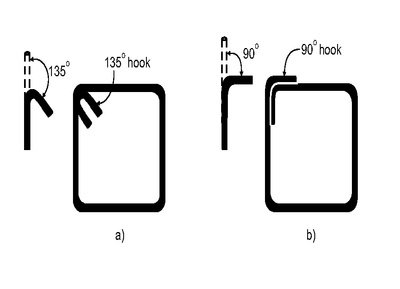
Ties in reinforced concrete columns: a) 135 degree hooks (ductile detailing), and b) 90 degree hooks (non-ductile detailing) (Brzev, S. and Pao, J. Reinforced Concrete Design: A Practical Approach, Pearson Learning Solutions, 2012)
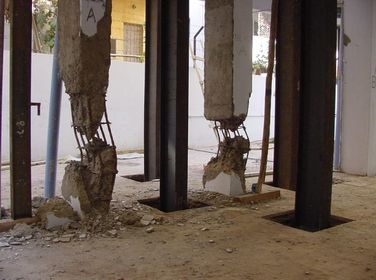
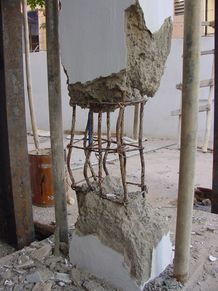
Failure of reinforced concrete columns at the ground floor level of a building with the soft storey irregularity in the 2001 Bhuj, India earthquake; the columns were characterized by non-ductile details, such as widely spaced ties and 90 degree hooks in ties (C.V.R. Murty, EERI Reconnaissance Team)
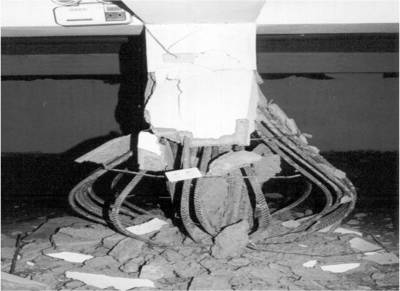
Failure at the base of a reinforced concrete column due to 90 degree hooks and widely spaced ties was observed in the 1999 Chi Chi, Taiwan earthquake; use of 90 degree hooks is a feature of non-ductile concrete construction (EERI Reconaissance Team)
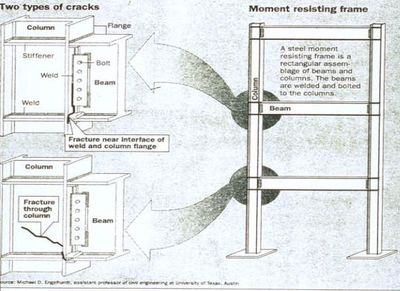
Older steel moment frame buildings were damaged in the 1994 Northridge, California earthquake due to non-ductile beam-column connections and weld fractures (EERI and Bay Area Regional Earthquake Preparedness Project, CAL-OES)
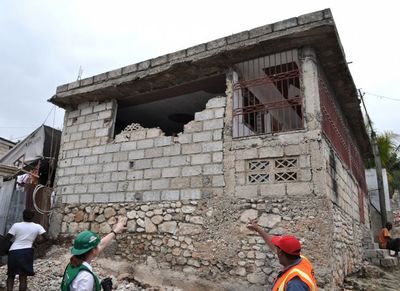
Damage of a poorly constructed confined masonry building in the 2010 Haiti earthquake; this is considered a non-ductile performance (A. Lang, EERI Reconnaissance Team)
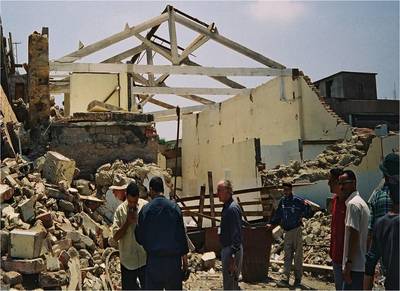
Unreinforced masonry buildings often show non-ductile performance and suffer damage in major earthquakes, such as the 2003 Boumerdes, Algeria earthquake (S. Brzev)
- Details
- Written by: admin
- Category: terms
- Hits: 707
Any school-age educational centre. Includes government-owned and private schools.


